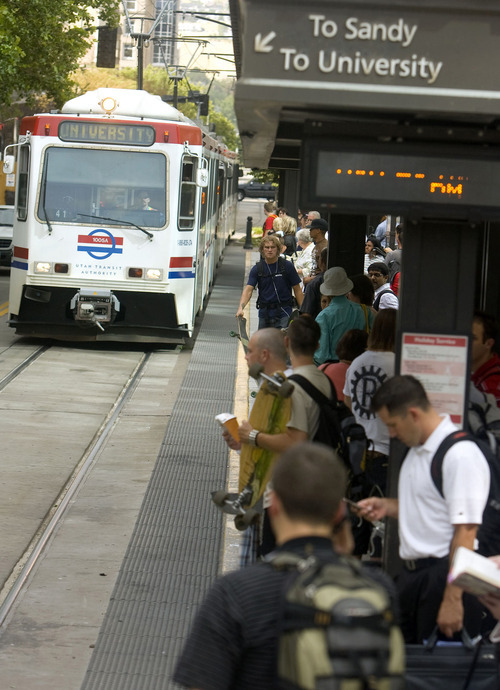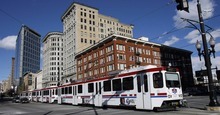This is an archived article that was published on sltrib.com in 2011, and information in the article may be outdated. It is provided only for personal research purposes and may not be reprinted.
His past two jobs allow Andrew Gruber to see easily why a new study says most transit agencies nationally do not connect people and jobs well — and why Utah is heralded as a bright-spot exception.
Gruber, executive director of the transportation-planning Wasatch Front Regional Council, said, "I came here from Chicago where I worked in the transit system. It's 100 years old and is a traditional hub-and-spoke system. It was designed to bring people from the suburbs into the central city where the jobs were."
But most jobs aren't downtown anymore. They moved to the suburbs, and the system wasn't designed to move people between suburbs — a problem faced in many metro areas nationwide.
"In contrast, along the Wasatch Front our transit system is relatively new," he said. And because the area is compactly boxed in by mountains, it was clear where growth would come and planners "were able to design a new transit network" that transports people to emerging suburban job centers.
That helps Utah areas rank unusually high in a study released Thursday by the Brookings Institution, a Washington-based nonprofit policy group, about how well transit agencies in the nation's top 100 metro areas connect people and jobs.
The Salt Lake metro area ranked No. 3, Provo-Orem ranked No. 9 and Ogden-Clearfield ranked No. 11.
"Utah is a strong example of how good planning and strong investment can really help metro areas effectively connect people to jobs," Elizabeth Kneebone, a coauthor of the Brookings study, told The Salt Lake Tribune.
In the top 100 metro areas nationally, the study figured that public transit buses and trains allow residents to reach only 30 percent of their area's jobs within a 90-minute ride.
In the Salt Lake metro area, transit allows reaching 59 percent of jobs — or two times better than average. In Provo-Orem, it reaches 48 percent. In Ogden-Clearfield, it reaches 42 percent.
Kneebone said areas that did well in the study share three key characteristics: Their transit networks are extensive and reach far into communities; most jobs are in relatively concentratedareas; and officials use integrated planning for where to allow housing, job areas and transportation systems.
"Utah has done each of these things right," Kneebone said. "You have efforts like Envision Utah. Its purpose is to think across these different areas of planning, and think of more comprehensive development patterns."
Gruber said connecting people to jobs via transit is a core part of his agency's regional planning — and is needed for the Wasatch Front to handle adding an expected 1.4 million additional people in the next 30 years without traffic gridlock.
He adds, "The region has had the vision to make significant investment in transit over the past 10 years. We have the highest per capita transit investment of any region in the area in the last 10 years," in building TRAX lines, FrontRunner commuter rail and bus rapid transit lines that have their own highway lanes.
Tyler Garcia, a planner for the Utah Transit Authority, said UTA came up with a unique sort of hybrid system to allow a more extensive reach into communities.
It is partially a hub-and-spoke system — with TRAX lines being the elongated hub into which local buses feed. It also has a grid system for buses where people can travel east-west, and north-south. Additionally, UTA has some express and fast buses for quick, direct service between big job and population centers.
He said UTA looked at planned growth, surveys of what people said they wanted, demographic and other data to redesign the system away from a traditional hub and spoke — such as a complete revamping of the Salt Lake County system in 2007, which he said has increased ridership.
Lorin Simpson, UTA general manager for Salt Lake County, said that trying to connect people and jobs "is definitely a high priority for us and a significant ridership generator."
Gruber also said companies considering relocating or expanding to Utah increasingly look at transit options available to their workers.
"Part of the reason for that is employers know often transit can provide a more predictable trip time from home to work, particularly on rail system, than the vagueries of traveling by car," he said.
Kneebone said she would like to see Utah "continue to be leader on these kind of issues. It really does show what good planning and good investment can do for metro areas."





